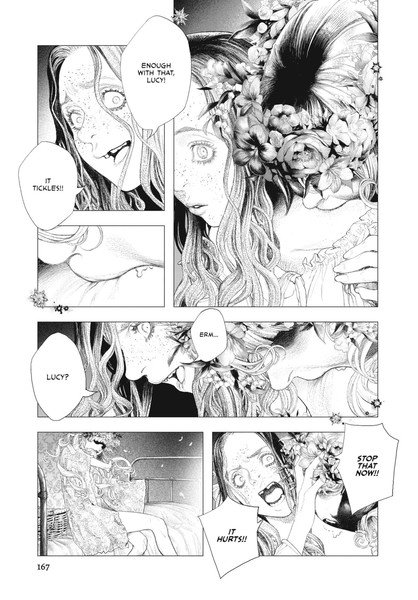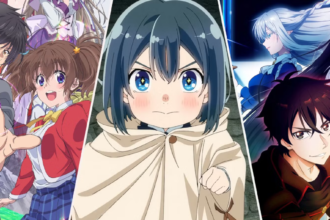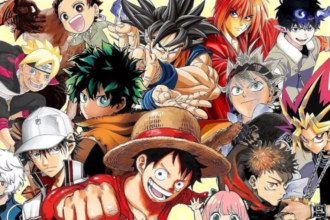by Ameen Sahban, Sep 20th 2024
Shin’ichi Sakamoto’s storied manga has at last begun coming stateside, with English releases of Innocent and #DRCL midnight children now several volumes in, and The Climber announced to be coming soon. #DRCL, a dramatic reimagining of Bram Stoker’s Dracula, was nominated for an Eisner Award earlier this year and won Best New Manga Series at the first annual American Manga Awards. We spoke with Sakamoto about his history in the manga medium, his creative processes, and his feelings on the challenge of depicting the world’s most famous monster.

You have been creating manga since the mid-1990s, coming into your current style with The Climber (Kokou no Hito). How has your creative process, and your approach to the kinds of stories you seek to tell with your manga, evolved throughout your career?
Shin’ichi Sakamoto: When I was drawing for boys’ magazines, my works were based on the dreams and hopes within me. Later, as I met my partner and experienced the birth of my daughter and son, the venue for my works shifted from youth magazines to general magazines, and along with that, my works changed to express my thoughts on society and my unique outlook on life.
The Climber, Innocent, and #DRCL are all manga that are based around pre-existing stories or real-world or historical figures. What is your reason for basing your works on these, as opposed to writing entirely original characters and stories?
Sakamoto: With The Climber, an unexpected direction was created by using a novel as the original [source material]. The original novel’s prestigious text by Mr. Jirō Nitta inspired me to try to illustrate its precise metaphorical expressions and descriptions that do not rely on onomatopoeia as a manga. I believe that using non-manga content and history as a subject matter helps to expand the potentialities of manga.
How familiar were you with the original text of Bram Stoker’s Dracula prior to beginning work on #DRCL? What led you to decide to adapt such a famous, well-known work?
Sakamoto: Like almost everyone else in the world, I was familiar with Dracula through movies and manga, but I had never read the novel. After finishing the serialization of Innocent, I was invited by Usamaru Furuya to create a doujinshi at a time when I had more time on my hands. At that time, I decided to try drawing a horror story, which I had longed to do, and I completed it alone in a one-shot entitled “Dorachu.” While searching for the next serialization to begin with, I re-read the original story and was impressed by how the image of Dracula and the characters were different from the general image and how the message of 120 years ago is still relevant today, and I felt that it had to be made into a manga.
There have been a multitude of other adaptations of Dracula throughout history. Are there any that are particular favorites of yours, and were there any versions of the story that influenced your take in #DRCL?
Sakamoto: During my childhood in the 1970s, Japan was in the midst of a horror manga boom. Shinichi Koga‘s Fearful Wolf Girl [恐怖のオオカミ少女/Kyōfu no Ōkami Shōjo] and Shinji Hama’s Vampire Girl Karen [吸血少女カレン/Kyūketsu Shōjo Karen] were particularly my favorites.
#DRCL is obviously not a direct, 1:1 adaptation of the events told in the Dracula novel. How did you decide what to keep and change from the source material? What did you feel was most important in adapting the novel?
Sakamoto: The late 19th century, the period in which the story is set, was also the time when capitalism developed and emerged, and calls for the expansion of rights for workers and women began, giving birth to values still relevant today. In the original work, Mina also reflects on the “new woman.” Lucy, the “most beautiful woman;” courted by men, is preyed upon by the Count, but Mina, who continues to keep records with her own ability and will, continues to fight in cooperation with everyone until the end while the men who protect and fight for Mina are also suffering and vulnerable. I feel it is my mission to revive this message from Bram Stoker in our time.

#DRCL
, like Innocent
before it, features some queer imagery and themes—the character of Luke/Lucy, in particular, crosses over many lines of gender and attraction. What is your interest in exploring these ideas and themes?
Sakamoto: What I always keep in mind when creating my work is to discard preconceived notions and assumptions and to portray things as honestly as they are, without taking any easy way out. It is easy to assume that love is born when there is a man and a woman, but the reality is more complicated. There are many different types of people on Earth, and they live in various ways. I want to continue to hold the belief that there is no such thing as a “queer” person.
Your approach to art and visual storytelling is different compared to many other manga. #DRCL, for instance, largely eschews written sound effects. What is your philosophy when it comes to visual storytelling in manga, and is there anything that has influenced your style of work?
Sakamoto: As for not including sound effects, I wanted to trust the power of the art. I draw trusting that readers will replay the sound effects in their brains, such as the sound of breaking glass or knocking on a door, based on their own experiences. What I have decided to do with the visuals is to avoid depicting grotesque scenes as they are. No matter how cruel the scene may be, I draw it with an awareness of beauty. Also, after hearing from an Italian manga artist that he studied anatomy in order to draw manga, I tried to draw with an awareness of muscles and skeletal structure.
In a 2020 interview, you mentioned that part of your artistic process involves taking reference photos of your assistants modeling clothing and costumes, some of which you sewed yourself. Had sewing previously been an interest and hobby of yours, or did you learn it specifically to supplement the creation of your manga?
Sakamoto: I am not good at sewing at all (laughs). Up until now, I have only sewed small items. For the dress in Innocent
, a fashion designer handcrafted an 18th-century robe à la française. The dress Mina wears in #DRCL
is a late 19th-century English antique dress provided by the former editor-in-chief of a fashion magazine. As a side note, for The Climber
, I asked a mountaineering manufacturer to provide us with real equipment to actually climb an 8000M peak. I am grateful for the cooperation of various people in the realism of the drawings!

The complexity of your process in creating your manga shows in how impressively detailed your art turns out. Do you feel your artistic process of creating these ornate illustrations has sped up as you’ve continued your craft, or has the amount of time you spend on it only increased and intensified?
Sakamoto: While digitalization continues to advance, #DRCL particularly emphasizes the warmth and shimmer of 19th-century handwork. The process of adjusting digitally drawn pictures by intentionally blurring and shifting them has increased the work process, which in turn has increased the production time. Digital technology is now indispensable in manga production, where deadlines are set. But I do not want to be dominated by digital technology, so I fight daily on the PC battlefield!
It is only relatively recently that your works have begun to be translated and released for English-speaking fans in the West, even as manga like Innocent and #DRCL were based on events and works that would be familiar to Western audiences. Do you have any thoughts or feelings on your manga at last gaining an audience and recognition in this part of the world, including #DRCL being nominated for an Eisner Award this year?
Sakamoto: As my work continues to be set overseas, I am particularly interested in the reaction of Western readers. Twenty years ago, it would have been unthinkable that Japanese manga could be translated and published so easily. I am also thrilled that a work being serialized in a Japanese magazine was nominated for an Eisner Award. We live in an age where messages from fans can be received directly from all over the world. Thanks to online translation software, I can communicate with a boy in Brazil on the other side of the world, transcending language and distance. I think it is a wonderful thing that the Internet has brought to us.
#DRCL has been running since the beginning of 2021, having been collected into four volumes so far as of this writing. What are your hopes for the series as it continues and for the readers to get out of it as they keep following it?
Sakamoto: I consider it a challenge to express Dracula, the world’s most famous monster, in my own way as a manga. Because the character is so well-known, his image has already been formed and established in people’s minds. I believe it is my mission to destroy this strongest preconceived image and update it to the modern era while taking into account the intent of the original work.










